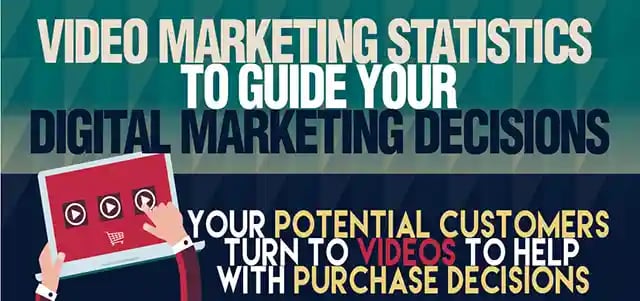The Power of Video Marketing: Boosting Your Digital Strategy and ROI
- Home
- The Power of Video Marketing: Boosting Your Digital Strategy and ROI

Nearly 50% of internet users seek out videos related to a product or service before visiting a store in London and across the United Kingdom. Considering that 68% of YouTube users watch videos before making a purchase decision, it's essential to leverage the power of video marketing to effectively influence your customers and guide them towards choosing your brand. By creating targeted and engaging video content, you can address the specific needs and challenges faced by marketing managers, ultimately driving results and fostering long-term relationships with your audience.
Table of Contents:
1. Introduction
2. The Impact of Video Marketing on Business Goals
2.1 Increase Brand Awareness and Reach a Wider Audience
2.2 Generate More Qualified Leads for the Sales Team
2.3 Improve Marketing ROI through Better Targeting and Campaign Optimization
3. Staying Current with Video Marketing Trends and Best Practices
3.1 Latest Video Marketing Statistics
3.2 Recent Trends in Video Marketing
3.3 Best Practices for Creating Engaging Video Content
4. Addressing Marketing Manager Pain Points with Video Marketing
4.1 Overcoming Limited Budget and Resources
4.2 Balancing Strategic Planning with Tactical Execution
4.3 Demonstrating the Value and ROI of Marketing Initiatives
5. Optimizing Video Marketing Across Multiple Channels
5.1 Creating Consistent Brand Messaging
5.2 Distributing and Promoting Video Content on Social Media Platforms
5.3 Incorporating Videos into Email Marketing Campaigns
6. Building and Maintaining a Strong Online Presence with Video Content
6.1 Benefits of a Robust Video Library on Your Website
6.2 Improving Search Engine Rankings and Driving Organic Traffic
6.3 Tips for Repurposing and Updating Video Content
7. Conclusion
8. Call-to-Action
1. Introduction
In today's rapidly evolving digital landscape, video marketing has emerged as a powerful tool for businesses looking to engage their audience and achieve their marketing objectives. With an ever-increasing number of consumers turning to online videos for entertainment and education, marketing managers need to leverage this medium to stay competitive and effectively communicate their brand's value proposition.
For the marketing manager's buyer persona, video marketing can play a significant role in addressing their goals and challenges. By strategically implementing video content in marketing campaigns, they can increase brand awareness, generate more qualified leads, and improve marketing ROI through better targeting and campaign optimization. Additionally, video marketing can help overcome the pain points of limited budget and resources, keep up with the rapidly evolving digital marketing landscape, and demonstrate the value of marketing initiatives to stakeholders.
In the following sections, we will explore the impact of video marketing on business goals, discuss the latest trends and best practices, and provide practical tips and insights for marketing managers to make the most of this powerful communication medium.

2. The Impact of Video Marketing on Business Goals
2.1 Increase Brand Awareness and Reach a Wider Audience
Video marketing has proven to be an effective method for increasing brand awareness and reaching a wider audience. Compelling video content can capture the attention of viewers, encourage social sharing, and improve the overall visibility of a brand. For example, successful video marketing campaigns like Dollar Shave Club's viral video or the engaging storytelling in Airbnb's "Live There" campaign have demonstrated the power of video to create buzz, drive conversations, and increase brand recognition.
2.2 Generate More Qualified Leads for the Sales Team
One of the primary goals for marketing managers is to attract and convert leads, and video content can significantly contribute to this objective. By creating informative and engaging videos that address the needs and interests of your target audience, you can encourage viewers to take action, such as signing up for a newsletter, requesting a demo, or making a purchase. By offering value through video content, you can build trust with your audience and nurture them through the buyer's journey, ultimately converting them into loyal customers.
2.3 Improve Marketing ROI through Better Targeting and Campaign Optimization
Investing in video marketing can lead to a higher return on investment (ROI) by allowing for better targeting and campaign optimization. Video analytics can provide valuable insights into viewer behaviour, preferences, and engagement levels. By analyzing these data, marketing managers can refine their targeting strategies, create more personalized content, and optimize campaigns to maximize results.
For example, understanding which videos resonate most with your audience can help you develop more effective content in the future. Additionally, A/B testing different video thumbnails, headlines, and calls-to-action can lead to higher click-through rates and conversions. By leveraging video analytics and continuously optimizing campaigns, marketing managers can drive better results and improve the overall ROI of their marketing efforts.

3. Staying Current with Video Marketing Trends and Best Practices
3.1 Update and Discuss the Latest Video Marketing Statistics
To stay competitive and make informed decisions, marketing managers must be aware of the latest video marketing statistics. Recent data shows that online video consumption continues to grow, with viewers spending an average of 100 minutes per day watching videos online in 2021, up from 84 minutes in 2020. Additionally, videos are responsible for 82% of all internet traffic, emphasizing the importance of incorporating video content into marketing strategies.
3.2 Explore Recent Trends in Video Marketing
Several trends have emerged in recent years that marketing managers should consider when developing their video marketing strategies. These include:
- Live streaming: Platforms like Facebook Live, Instagram Live, and YouTube Live have made it easier than ever for brands to engage with their audiences in real-time. Live streaming can be an excellent way to showcase events, conduct Q&A sessions, and provide exclusive behind-the-scenes content.
- Interactive videos: Interactive videos allow viewers to engage directly with the content by clicking on hotspots, answering quizzes, or navigating through different scenes. This can lead to higher engagement levels and a more personalized experience for viewers.
- Personalized content: Personalized video content, such as individualized product recommendations or tailored video messages, can create a more meaningful connection with viewers and improve conversion rates.
3.3 Share Best Practices for Creating Engaging and Effective Video Content
To create engaging and effective video content, marketing managers should consider the following best practices:
- Tell a story: Use storytelling to connect with your audience emotionally and create a memorable experience. Focus on the benefits and value your product or service brings to customers, rather than just listing features.
- Keep it short and sweet: Attention spans are shorter than ever, so it's essential to convey your message concisely. Aim for videos that are between 1-2 minutes for maximum impact, while longer-form content can be used for more in-depth topics.
- Prioritize quality: Invest in high-quality visuals, sound, and editing to ensure your video content is professional and engaging. Poor production quality can reflect negatively on your brand and detract from your message.
- Include a clear call-to-action: Encourage viewers to take the next step by including a clear call-to-action (CTA) in your video, such as visiting your website, downloading a resource, or making a purchase.
- Optimize for SEO: Make your videos easier to find by optimizing titles, descriptions, and tags with relevant keywords. Also, consider creating a video transcript or captions to improve accessibility and boost SEO.
- Test and measure: Continuously evaluate the performance of your videos and make data-driven decisions to optimize future content. Utilize video analytics to gain insights into viewer behaviour, preferences, and engagement levels.

4. Addressing Marketing Manager Pain Points with Video Marketing
4.1 Limited Budget and Resources
Marketing managers often face budget and resource constraints, but video marketing can still be effective and accessible with the right approach. By utilizing cost-effective video production techniques and tools, it's possible to create high-quality content without breaking the bank. Some suggestions include:
- DIY production: Use smartphones or affordable cameras for filming and free or low-cost editing software to create professional-looking videos.
- Crowdsource content: Encourage employees or customers to contribute video testimonials, reviews, or behind-the-scenes footage.
- Repurpose existing content: Transform blog posts, presentations, or infographics into engaging video content.
- Utilize templates and stock footage: Use video templates or stock footage available on platforms like Canva or Storyblocks to create polished videos quickly and cost-effectively.
4.2 Balancing Strategic Planning with Tactical Execution
To balance long-term strategic planning with day-to-day tactical execution, marketing managers should develop a comprehensive video marketing plan that outlines their goals, target audience, and key performance indicators (KPIs). This plan should also include a content calendar that details the topics, formats, and platforms for each video.
By having a clear roadmap, marketing managers can efficiently execute short-term campaigns while staying aligned with their long-term objectives. Regularly reviewing and adjusting the plan based on performance data and industry trends will ensure continued success and adaptability.
4.3 Demonstrating the Value and ROI of Marketing Initiatives
Demonstrating the value and ROI of video marketing initiatives is crucial for gaining stakeholder buy-in and securing ongoing support. By providing case studies that highlight the success of video marketing campaigns, marketing managers can showcase tangible results and prove the worth of their efforts.
For example, a case study could detail how a software company used a series of product demo videos to increase free trial sign-ups by 35%, leading to a significant boost in revenue. Or, it could highlight how an e-commerce brand leveraged user-generated video content to increase social media engagement and drive a 25% increase in sales.
By presenting data-driven evidence of the impact of video marketing on key business objectives, marketing managers can confidently demonstrate the value of their initiatives and secure ongoing support for their strategies.

5. Optimizing Video Marketing Across Multiple Channels
5.1 Importance of Creating a Consistent Brand Message Across Platforms
A consistent brand message across all marketing channels is crucial for building brand recognition and trust with your target audience. To achieve this consistency, ensure that your video content aligns with your overall brand voice, visual identity, and messaging. By presenting a unified brand experience, you can effectively reinforce your brand's value proposition and establish a strong connection with your audience.
5.2 Strategies for Distributing and Promoting Video Content on Various Platforms
Each platform has its unique features and audience preferences. To optimize your video marketing across multiple channels, tailor your content and promotion strategies accordingly:
- YouTube: Focus on creating engaging, informative, and entertaining content that addresses your audience's needs and interests. Optimize video titles, descriptions, and tags with relevant keywords for better discoverability. Use annotations, end screens, and playlists to guide viewers to related content and encourage deeper engagement.
- Facebook: Upload native videos directly to Facebook for better organic reach and engagement. Utilize Facebook's targeting tools to reach your desired audience and consider investing in paid promotion for greater visibility. Engage with your audience through comments and shares to foster community and drive further reach.
- Instagram: Create visually appealing, short-form video content that captures attention quickly. Utilize Instagram Stories, Reels, and IGTV for various video formats and lengths. Use hashtags strategically to increase discoverability and engage with your audience through comments and direct messages.
- LinkedIn: Produce professional, industry-specific video content that positions your brand as an authority in your field. Share your videos as native content on your company page or personal profile, and engage with your professional network through likes, comments, and shares.
5.3 Incorporating Videos into Email Marketing Campaigns for Better Engagement
Incorporating videos into your email marketing campaigns can significantly improve engagement, leading to higher open rates, click-through rates, and conversions. To effectively use videos in your email marketing, consider the following tips:
- Use a captivating thumbnail: Include an eye-catching thumbnail with a play button to encourage recipients to click through and watch the video.
- Optimize the subject line: Mention the video in your subject line to pique the interest of your subscribers and increase open rates. For example, use phrases like "Watch our latest video" or "Exclusive video inside."
- Keep it relevant: Ensure that the video content is relevant to your audience and aligns with the overall purpose of your email. The video should provide value and complement the other content within the email.
- Track performance: Monitor video engagement metrics within your email campaigns to better understand your audience's preferences and optimize future content accordingly.

6. Building and Maintaining a Strong Online Presence with Video Content
6.1 Benefits of a Robust Video Library on Your Website
Having a robust video library on your website offers several benefits that contribute to a stronger online presence:
- Enhanced user experience: A diverse and well-organized video library caters to different user preferences and needs, making your website more engaging and informative.
- Increased dwell time: Engaging video content encourages visitors to spend more time on your site, which can positively impact search engine rankings.
- Demonstrated expertise: A comprehensive video library showcases your brand's expertise, helping to establish your company as an industry authority and building trust with your audience.
6.2 Improving Search Engine Rankings and Driving Organic Traffic with Video Content
Video content can significantly improve search engine rankings and drive organic traffic to your website. To optimize your video content for search engines, consider the following strategies:
- Add video transcripts: Including transcripts of your videos makes them accessible to a broader audience and provides search engines with additional indexable content.
- Optimize metadata: Write engaging video titles and descriptions that incorporate relevant keywords to improve search visibility.
- Create video sitemaps: Submit a video sitemap to search engines to help them better understand and index your video content.
6.3 Tips for Repurposing and Updating Video Content to Maximize its Value
Repurposing and updating video content can help you extend its lifespan, reach new audiences, and maximize its value. Here are some tips for getting the most out of your video content:
- Repurpose content for different platforms: Tailor your video content to suit the unique requirements and audience preferences of various platforms, such as creating shorter clips for Instagram or adding subtitles for Facebook.
- Transform other content formats into the video: Convert blog posts, infographics, or presentations into video content to engage your audience in a new way and expand your video library.
- Update outdated content: Regularly review your video library and update any outdated information or visuals to ensure your content remains relevant and accurate.
- Re-promote evergreen content: Share and re-promote evergreen video content periodically to attract new viewers and maintain its value over time.
7. Conclusion
In conclusion, video marketing plays a vital role in addressing the goals and challenges faced by the marketing manager's buyer persona. By leveraging the power of video content, marketing managers can increase brand awareness, generate qualified leads, and improve marketing ROI. Additionally, staying current with video marketing trends and best practices can help overcome challenges such as limited budget and resources, balancing strategic planning with tactical execution, and demonstrating the value and ROI of marketing initiatives.
Embracing video marketing and optimizing it across multiple channels, such as YouTube, Facebook, Instagram, and LinkedIn, contributes to building and maintaining a strong online presence for your brand. By creating engaging, informative, and targeted video content, marketing managers can make a significant impact on their company's bottom line and overall success.
Don't miss the opportunity to harness the potential of video marketing for your business. Take action today by contacting Whitehat SEO Ltd for a consultation or downloading our comprehensive video marketing guide. Let us help you craft a compelling video marketing strategy that addresses your specific goals and challenges, and propels your brand towards success in the digital landscape.
FAQ Section
Q1: Why is video marketing essential for marketing managers?
A1: Video marketing is crucial for marketing managers because it helps increase brand awareness, generate qualified leads, and improve marketing ROI. It also addresses specific challenges faced by marketing managers, such as limited budget, balancing strategic planning with tactical execution, and demonstrating the value and ROI of marketing initiatives.
Q2: What are some current trends in video marketing?
A2: Current trends in video marketing include live streaming, interactive videos, personalized content, and the growing importance of mobile video consumption.
Q3: How can video content improve search engine rankings?
A3: Video content can improve search engine rankings by increasing user engagement, dwell time, and providing additional indexable content through video transcripts. Optimizing metadata and submitting video sitemaps can also enhance search visibility.
Q4: What are some cost-effective video production techniques and tools?
A4: Cost-effective video production techniques and tools include using smartphones for filming, leveraging free or affordable editing software, utilizing stock footage and images, and tapping into user-generated content.
Q5: How can I distribute and promote video content on different platforms?
A5: Tailor your video content to suit the unique requirements and audience preferences of various platforms. Create shorter clips for Instagram, add subtitles for Facebook, and optimize video descriptions and titles for YouTube. Additionally, incorporate videos into email marketing campaigns for better engagement.
Q6: How often should I update my video content?
A6: Regularly review your video library and update any outdated information or visuals as needed. It's crucial to keep your content relevant and accurate for your audience. Additionally, consider repurposing and re-promoting evergreen content periodically to maintain its value over time.
Learn more about our video marketing services to let us help you increase your brand today.

